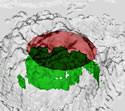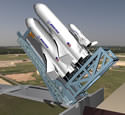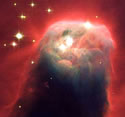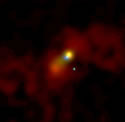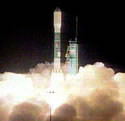
Image credit: NASA
NASA’s newest Earth observation satellite launched Saturday aboard a Boeing Delta II rocket. Called Aqua, the satellite will gather data about global precipitation, evaporation and the cycling of water to help scientists understand if there’s any acceleration of the Earth’s water cycle and due to changing climate. The infrared sounder on board will measure the Earth’s atmosphere and help improve weather prediction.
NASA’s latest Earth observing satellite, Aqua, carrying the NASA Jet Propulsion Laboratory-managed Atmospheric Infrared Sounder instrument, successfully launched this morning at 2:55 a.m. Pacific Time. Aqua is dedicated to advancing our understanding of Earth’s water cycle and our environment. Launching the Aqua spacecraft marks a major milestone in support of NASA’s mission to help us better understand and protect our planet.
The Aqua spacecraft lifted off from the Western Test Range of Vandenberg Air Force Base, Calif., aboard a Delta II rocket. Spacecraft separation occurred at 3:54 a.m. Pacific Time, inserting Aqua into a 705-kilometer (438-mile) orbit.
“The Aqua project has truly been a team effort and we are very excited this morning,” said Aqua project manager Phil Sabelhaus at NASA’s Goddard Space Flight Center, Greenbelt, Md.
The primary goal of Aqua, as the name implies, is to gather information about water in Earth’s system. Equipped with six state-of-the-art instruments, Aqua will collect data on global precipitation, evaporation and the cycling of water. This information will help scientists all over the world to better understand Earth’s water cycle and determine if the water cycle is accelerating as a result of climate change.
JPL’s Atmospheric Infrared Sounder will measure Earth’s atmosphere and surface, allowing scientists to improve weather prediction and observe changes in Earth’s climate.
Aqua is the latest in a series of Earth Observing System spacecraft, following the Terra satellite launched in December 1999. Aqua will cross the equator daily at 1:30 p.m. as it heads north. The early afternoon observation time contrasts with the Terra satellite, which crosses the equator between 10:30 and 10:45 a.m. daily. Aqua’s afternoon observations, combined with Terra’s morning observations, will provide important insights into the daily cycling of key scientific parameters such as precipitation and ocean circulation.
Aqua is a joint project among the United States, Japan and Brazil. The United States provided the spacecraft and four of the six scientific instruments. In addition to the JPL-provided Atmospheric Infrared Sounder, the other U.S. instruments include the Moderate Resolution Imaging Spectroradiometer and the Advanced Microwave Sounding Unit, both provided by the Goddard center, and the Clouds and the Earth’s Radiant Energy System, provided by NASA’s Langley Research Center, Hampton, Va.
Japan’s National Space Development Agency provided the Advanced Microwave Scanning Radiometer, while the Instituto Nacional de Pesquisas Espaciais (the Brazilian Institute for Space Research) provided the Humidity Sounder for Brazil.
Aqua is part of NASA’s Earth Science Enterprise, a long-term research effort dedicated to understanding and protecting our home planet. Through the study of Earth, NASA will help to provide sound science to policy and economic decision makers so as to better life here, while developing the technologies needed to explore the universe and search for life beyond our home planet.
Original Source: NASA/JPL News Release

